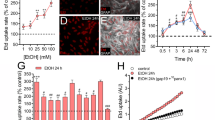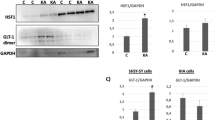Abstract
Ethanol intake is associated with increase in lipid peroxidation and formation of reactive oxygen species in different cerebral areas, in neurons as well as in astrocytes. The latter's integrity is essential for the normal growth of neurons. In previous studies we observed, in different cerebral areas of both acutely and chronically ethanol-treated rats, correlation between ethanol-induced oxidative stress and the increased expression of HSP70 (70 kDa heat shock proteins), chaperonins having a protective and stabilizing effect on stress–induced cell injury. In this study we examined, in vitro, the role of HSP70 on chronically ethanol-treated rat astrocytes by transfection with an anti-HSP70 antisense oligonucleotide. The results show that treatment with ethanol, from 50 to 100 mmol/L, induces a dose-dependent increase in the production of reactive oxygen species and of HSP70 levels, together with an impairment of the respiratory chain activity and a decrease in cell viability. In addition, our data indicate a drastic reduction of cellular metabolism in HSP70-deprived astrocytes, particularly when these cells were also ethanol-treated. In fact, transfection with HSP70 antisense induced moderate oxidative damage in control astrocytes and, consequently, a drastic decrease in the viability of ethanol-treated cells, with the mitochondrial functionality being particularly affected. Our results confirm that heat shock proteins confer a survival advantage to the astrocytes, preventing oxidative damage and nuclear DNA damage as well, and suggest the development of new drugs exerting a cytoprotective role either in physiological, or pathological conditions.
Similar content being viewed by others
References
Andreoli SP, Mallett CP, Bergstein JM. Role of gluathione in protecting endothelial cells against hydrogen peroxide oxidant injury J Lab Clin Med. 1986;108(3):190–8.
Aquino DA, Peng D, Lopez C, Farooq, M. The constitutive heat shock protein 70 is required for optimal expression of myelin basic protein during differentiation of oligodendrocytes. Neurochem Res. 1998;23:413–20.
Bailey SM, Pietsh EC, Cunningham C. Ethanol stimulates the production of reactive oxygen species at mitochondrial complexes I and III. Free Radic Biol Med. 1999;27:891–900.
Bradford MM. A rapid and sensitive method for the quantitation of microgram quantities of protein utilizing the principle of protein-dye binding. Anal Biochem. 1976;72:248–54.
Bukau B and Horwich AL. The HSP70 and HSP60 chaperone machines. Cell. 1998;92:351–66.
Buzzard KA, Giaccia AJ, Killender M, Anderson RL. Heat shock protein 72 modulates pathways of stress-induced apoptosis. J Biol Chem. 1998;273:17147–53.
Calabrese V, Renis M, Calderone A, Russo A, Barcellona ML and Rizza V. Stress proteins and SH-groups in oxidant-induced cell damage after acute ethanol administration in rat. Free Radic Biol Med. 1996;20:391–7.
Calabrese V, Renis M, Calderone A, et al. Stress proteins and SH-groups in oxidant-induced cellular injury after chronic ethanol administration in rat. Free Radic Biol Med. 1998;24:1159–67.
Cammer W, Tansey F, Abramovitz M, Ishigaki S, Listowsky I. Differential localization of glutathione-S-transferase Yp and Yb subunits in oligodendrocytes and astrocytes of rat brain. J Neurochem. 1989;52:876–83.
Chanvitayapongs S, Draczynska-Lusiak B, Sun AY. Amelioration of oxidative stress by antioxidants and resveratrol in PC12 cells. Neuro Rep. 1997;8:1499–502.
Chen YC, Lin Shian SY, Lin JK. Involvement of heat shock protein 70 and P53 proteins in attenuation of UVC-induced apoptosis by thermal stress in hepatocellular carcinoma cells. Photochem Photobiol. 1999;70:78–86.
Copin JC, Leding M, Tholey G. Free radicals scavenging systems of rat astroglias cells in primary culture: effects of anoxia and drug treatment. Neurochem Res. 1992;17:677–82.
Diomede L, Colotta B, Piovana F, Re EJ, Modest M, Salmona M. Induction of apoptosis in human leukemic cells by the ether lipid 1-octadecyl-2-methyl-rac-glycero-3-phosphocoline: a possible basis for its selective action. Int J Cancer. 1993;53:124–30.
Esteve JM, Mompo J, Garcia De La Asuncion J, et al. Oxidative damage to mitochondrial DNA and glutathione oxidation in apoptosis. Studies “in vivo” and “in vitro”. FASEB J. 1999;13:1055–64.
Fonseca VA, Stone A, Munshi M, et al. Oxidative stress in diabetic macrovascular disease: does homocysteine play a role. South Med J. 1997;90:903–6.
French SW, Wong K, Jui L, Albano E, Hagbjork AL, Ingelman-Sundberg M. Effect of ethanol on cytochrome P450 2E1 (CYP2E1), lipid peroxidation, and serum protein adduct formation in relation to liver pathology pathogenesis. Exp Mol Pathol. 1993;58:61–75.
Gabai VL, Meriin AB, Mosser DD, et al. HSP70 prevents activation of stress kinase. A novel pathway of cellular thermotolerance. J Biol Chem. 1997;272:18033–7.
Gassen M, Youdim MB. The potential role of iron chelators in the treatment of Parkinson's disease and related neurological disorders. Pharmacol Toxicol. 1997;80:159–66.
Good PF, Werner P, Hsu A, Olanow CW, Perl DP. Evidence of neuronal oxidative damage in Alzheimer's disease. Am J Pathol. 1996;149:21–8.
Holownia A. Ethanol-induced cell death in cultured rat astroglia. Neurotoxicol Teratol. 1997;19:141–6.
Hunot S, Brugg B, Ricarp D, et al. Nuclear traslocation of NFκB is increased in dopaminergic neurons of patients with Parkinson disease. Proc Natl Acad Sci USA. 1997;94:7531–6.
Jaattela M, Wissing D, Kokholm K, Kallunk T, Egebland M. HSP70 exerts its antiapoptotic function downstream of caspase-3-like proteases. EMBO J. 1998;17:6124–34.
King TE. Preparation of succinate cytochrome c reductase and the cytochrome b-cl particle and reconstitution of succinate cytochrome c reductase. Methods Enzymol. 1967;10:216–25.
Kowaltowski AJ, Vercesi AE. Mitochondrial damage induced by conditions of oxidative stress. Free Radic Biol Med. 1999;26:463–71.
Laemli UK. Cleavage of the structural proteins during the assembly of the head of bacteriophage T4. Nature. 1970;277:680–5.
Montoliu C, Sancho-Tello H, Azorin I, et al. Ethanol increases cytochrome P-450 2E1 and induces oxidative stress in astrocytes. J Neurochem. 1995;65:2561–70.
Morimoto RI. Cells in stress: transcriptional activation of heat shock genes. Science. 1993;259:1409–10.
Morimoto RI, Santoro G. Stress-inducible responses and heat shock proteins: new pharmacologic targets for cytoprotection. Nature Biotechnol. 1998;16:833–8.
Mosmann T. Rapid colorimetric assay for cellular growth and survival: application to proliferation and cytotoxicity assays. J Immunol Methods. 1983;65:55–63.
Murphy TH, Baraban JM. Glutamate toxicity in immature cortical neurons precedes development of glutamate receptor currents. Dev Brain Res. 1990;57:146–50.
Nordmann R, Ribiere C, Rouach H. Implication of free radical mechanisms in ethanol-induced cellular injury. Free Radic Biol Med. 1992;12:219–40.
Polla BS, Kantengwa S, Francois D, et al. Mithocondria are selective targets for the protective effects of heat shock against oxidative injury. Proc Natl Acad Sci USA. 1996;93:6458–63.
Ragan CI, Wilson MT, Darley-Usmar VM, Lowe PN. Subfraction of mitochondria and isolation of the proteins of oxidative phosphorilation. In: Darley-Usmar VM, Rickwood D, Wilson MT, eds. Mithocondria, a pratical approach. London: IRL Press; 1987:79–112.
Renis M, Di Giacomo C, Sorrenti V, et al. Heat shock proteins following rat cerebral ischemic/reperfusion episode: effect of ketamine. Biochem Mol Biol Int. 1994;33:345–54.
Renis M, Calabrese V, Russo A, Calderone A, Barcellona ML, Rizza V. Nuclear DNA strand breaks during ethanol-induced oxidative stress in rat brain. FEBS Lett. 1996;390:153–6.
Renis M, Cardile V, Russo A, Campisi A, Collovà F. Glutamine synthetase activity and HSP70 levels in cultured rat astrocytes: effect of 1-octadecyl-2-methyl-rac-glycero-3-phosphocoline. Brain Res. 1998;783:143–50.
Rossi A, Elia G, Santoro MG. 2-Cyclopenten-1-one, a new inducer of heat shock protein 70 with antiviral activity. J Biol Chem. 1996;271:32192–6.
Sagara J, Miura K, Bannai S. Maintenance of neuronal glutathione by glial cells. J Neurochem. 1993;61:1672–6.
Sharp FR. Heat-shock protein protection. TINS. 1999;3:97–9.
Shawn S, Jayatilleke E, Lieber CS. The effect of chronic alcohol feeding on lipid peroxidation in microsomes: lack of relationship to hydroxyl radical generation. 1984;118(1):233–8.
Singh NP, Tice RR, Stephen RE, Schneider EL. A microgel electrophoresis technique for the direct quantification of DNA damage and repair in individual fibroblasts cultured on microscope slides. Mut Res. 1991;252:289–96.
Vanella A, Avola R, Condorelli DF, et al. Antioxidant enzymatic activitics and resistance to oxidative stress in primary and subcultured rat astroglial cells. Int J Dev Neurosci. 1989;7:233–41.
Volloch V, Mosser DD, Massie B, Sherman MY. Reduced thermotolerance in aged cells results from a loss of an hsp72-mediated control of JNK signaling pathway. Cell Stress Chaperones. 1998;3:265–71.
Wharton DC, Tzagoloff A. Cytochrome oxidase from beef heart mitochondria. Methods Enzymol. 1967;10:245–50.
Yenari MA, Fink SL, Sun GH, et al. Gene therapy with HSP72 is neuroprotective in rat models of stroke and epilepsy. Ann Neurol. 1998;44:584–91.
Author information
Authors and Affiliations
Rights and permissions
About this article
Cite this article
Russo, A., Palumbo, M., Scifo, C. et al. Ethanol-induced oxidative stress in rat astrocytes: role of HSP70. Cell Biol Toxicol 17, 153–168 (2001). https://doi.org/10.1023/A:1011936313510
Issue Date:
DOI: https://doi.org/10.1023/A:1011936313510




